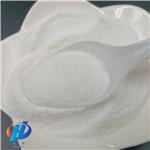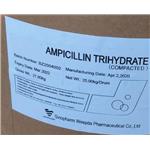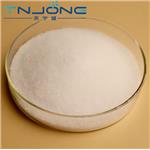- Ampicillin
-

- $15.00/ kg
-
2024-04-25
- CAS:69-53-4
- Min. Order: 1kg
- Purity: 99.912%
- Supply Ability: 10ton
- Ampicillin
-

- $0.00 / 25kg
-
2024-04-25
- CAS:69-53-4
- Min. Order: 25kg
- Purity: ≥96%
- Supply Ability: 10tons
- Ampicillin Trihydrate
-

- $0.00 / 1kg
-
2024-04-24
- CAS:69-53-4
- Min. Order: 1kg
- Purity: 99%
- Supply Ability: 1000kg
Related articles - Ampicillin vs Amoxicillin
- Ampicillin and amoxicillin are penicillin-type antibiotics used to treat bacterial infections of the middle ear and respirator....
- Mar 12,2024
|
| | Ampicillin Chemical Properties |
| Melting point | 198-200 °C (dec.)(lit.) | | alpha | D23 +287.9° (c = 1 in water) | | Boiling point | 201.8°C (rough estimate) | | density | 1.2794 (rough estimate) | | refractive index | 1.6320 (estimate) | | storage temp. | 2-8°C | | solubility | NH4OH 1 M: 50 mg/mL, clear, colorless | | form | solid | | color | White to Pale Yellow | | pka | 2.5 (COOH)(at 25℃) | | Water Solubility | 13.9g/L(25 ºC) | | JECFA Number | 85 | | Merck | 13,591 | | BRN | 1090925 | | Stability: | Stable, but may be moisture sensitive. Incopmpatible with strong oxidizing agents. | | InChIKey | AVKUERGKIZMTKX-NJBDSQKTSA-N | | CAS DataBase Reference | 69-53-4(CAS DataBase Reference) | | IARC | 3 (Vol. 50) 1990 | | EPA Substance Registry System | Ampicillin (69-53-4) |
| | Ampicillin Usage And Synthesis |
| Brand Name(s) | Human forms include Omnipen, Principen, Totacillin, Polycillin. Injectable forms include Omnipen-N, Polycillin-N, TotacillinN.
Veterinary forms include Amp-Equine, and Ampicillin trihydrate (Polyflex).
| | Description | Ampicillin is an antibacterial antibiotic from the α-aminobenzyl penicillin group, which differs from penicillin by the presence of an amino group that facilitates penetration through the outer membrane of some gram-negative bacteria.
Ampicillin is Semi-synthetic derivative of penicillin that functions as an orally active broad-spectrum antibiotic. Ampicillin acts by interfering directly with the biosynthesis of peptidoglycan, which constitutes the major component of the bacterial cell wall, leading to structural instability and death of bacteria.
Ampicillin is a β-lactam antibiotic within the penicillin family. As a member of this family, Ampicillin is susceptible to β-lactamase, which hydrolyzes the β-lactam ring. This broad spectrum antibiotic is effective against gram-positive, gram-negative bacteria and anaerobic bacteria. Ampicillin is widely used in cell culture as a selective agent. As an antibiotic, Ampicillin binds to penicillin binding proteins (PBPs) on a susceptible organism and Inhibits bacterial cell-wall synthesis by inactivating transpeptidases on the inner surface of the bacterial cell membrane. After binding to the PBPs, Ampicilin acts as a structural analogue of acyl-D-alanyl-D-alanine, acylates the transpeptidase enzyme and thereby prevents the cross-linking of the peptidoglycan of the cell wall necessary for the growth of the bacterium.
Ampicillin sodium can be used as a selective agent in several types of isolation media. Ampicillin sodium is routinely used to select for cells containing the pcDNA3.1 and pEAK10 resistance plasmids in cell line A904L at an effective concentration of 50 μg/ml. | | Chemical Properties | Crystalline Solid | | Chemical Properties | Ampicillin in anhydrous form occurs as
crystals. | | Originator | Binotal,Bayer,W. Germany,1962 | | Uses | β-lactam antibiotics | | Uses | Ampicillin caused contact dermatitis in a nurse also
sensitized to amoxicillin (with tolerance to oral
phenoxymethylpenicillin), and in a pharmaceutical
factory worker. | | Uses | Labelled Ampicillin. Orally active, semi-synthetic antibiotic; structurally related to penicillin. Antibacterial. | | Definition | ChEBI: A penicillin in which the substituent at position 6 of the penam ring is a 2-amino-2-phenylacetamido group. | | Manufacturing Process | α-Carbobenzyloxyaminophenylacetic acid (0.1 mol), which is obtained by the
reaction of equivalent quantities of α-aminophenylacetic acid and benzyl
chlorocarbonate in aqueous sodium hydroxide, dissolved in dry acetone is
stirred and cooled to approximately -5°C. To this there is added dropwise with
continued cooling and stirring a solution of ethyl chlorocarbonate (0.1 mol).
After approximately 10 minutes, the acylating mixture is cooled to about -5°C
and then is slowly added to a stirred ice-cold mixture of 6-aminopenicillanic
acid (0.1 mol), 3% sodium bicarbonate solution (0.1 mol) and acetone. This
reaction mixture is allowed to attain room temperature, stirred for an
additional thirty minutes at this temperature and then is extracted with ether.
The extracted aqueous solution is covered with butanol and the pH adjusted
to 2 by the addition of HCl. The acidified aqueous phase is extracted with
butanol, the pH of the aqueous phase being adjusted to pH 2 each time. The
combined butanol solutions which contain the free acid, α-
carbobenzyloxyaminobenzylpenicillin, are washed with water, and are then
shaken with water to which sufficient 3% sodium bicarbonate has been added
to bring the aqueous phase to pH 7. The process of washing and shaking is
repeated with fresh water and bicarbonate solution. The combined aqueous
solutions are washed with ether and then are evaporated under reduced
pressure and low temperature. The product, the sodium salt of α-
carbobenzyloxyaminobenzylpenicillin, is obtained as a yellow solid in a yield of
65%.
A suspension of palladium on barium carbonate (3.7 grams of 30%) in water
(20 ml) is shaken in an atmosphere of hydrogen at room temperature. The
catalyst is then filtered and washed well with water, care being taken that it
does not become dry. A solution of the sodium salt of α-
carbobenzyloxyaminobenzylpenicillin (4 grams) in water (20 ml) is added to
the pretreated catalyst and the suspension is shaken in an atmosphere of
hydrogen at room temperature and pressure for one hour. The catalyst is then filtered off, washed well with water, and the combined filtrate and washings
adjusted to pH 7 with hydrochloric acid. The resulting solution is evaporated in
vacuum at a temperature below 20°C to give α-aminobenzylpenicillin (2.4
grams, 74% yield), which is assayed at approximately 48% pure by the
manometric method. | | Brand name | Amcill (Parke-Davis); Omnipen (Wyeth-Ayerst);
Polycillin (Apothecon); Principen (Apothecon). | | Therapeutic Function | Antibacterial | | General Description | Ampicillin was synthesized by Beecham Research Laboratories in 1961 and evaluated for its anti-gram-negative activity by Rolinson et al.. It was the first semisynthetic penicillin showing strong activity against gramnegative bacilli. Although it is hydrolyzed by bacterial penicillinase, it is active against Escherichia coli, Shigella, Proteus mirabilis, and Haemophilus influenzae and is used very widely as an oral antibiotic. Ampicillin also is used by injection for serious infections. | | Contact allergens | Ampicillin caused contact dermatitis in a nurse also
sensitized to amoxicillin (with tolerance to oral phenoxymethylpenicillin)
and in a pharmaceutical factory
worker. Systemic drug reactions are common. Crossreactivity
is regular with ampicillin and can occur with
other penicillins. | | Safety Profile | Poison by intracerebral route. Moderately toxic by intraperitoneal route. Human systemic effects by ingestion: fever, agranulocytosis, and other blood effects. An experimental teratogen. Mutation data reported. Questionable carcinogen. When heated to decomposition it emits very toxic fumes of NO, and SOx,. | | Potential Exposure | Used as an antibiotic. | | Veterinary Drugs and Treatments | In dogs and cats, ampicillin is not as well absorbed after oral administration
as amoxicillin and its oral use has largely been supplanted
by amoxicillin. It is used commonly in parenteral
dosage
forms when an aminopenicillin is indicated in all species.
The aminopenicillins, also called the “broad-spectrum” or ampicillin
penicillins, have increased activity
against many strains of
gram-negative aerobes not covered by either the natural penicillins
or penicillinase-resistant penicillins, including some strains of E.
coli, Klebsiella, and Haemophilus. | | First aid | If this chemical gets into the eyes, remove anycontact lenses at once and irrigate immediately for at least medical attention. Give large quantities of water and inducevomiting. Do not make an unconscious person vomit.15 min, occasionally lifting upper and lower lids. Seek medical attention immediately. If this chemical contacts theskin, remove contaminated clothing and wash immediatelywith soap and water. Seek medical attention immediately. Ifthis chemical has been inhaled, remove from exposure,begin rescue breathing (using universal precautions, including resuscitation mask) if breathing has stopped and CPR ifheart action has stopped. Transfer promptly to a medicalfacility. When this chemical has been swallowed, get | | storage | Color Code—Green: General storage may be used.Prior to working with this chemical you should be trained onits proper handling and storage. Store in tightly closedcontainers in a cool, well-ventilated area away from strongoxidizers and moisture. | | Shipping | UN3077 Environmentally hazardous substances,
solid, n.o.s., Hazard class: 9; Labels: 9-Miscellaneous hazardous
material, Technical Name Required. | | Incompatibilities | May be incompatible with oxidizers
(chlorates, nitrates, peroxides, permanganates, perchlorates,
chlorine, bromine, fluorine, etc.); contact may cause fires
or explosions. Keep away from alkaline materials, strong
bases, strong acids, oxoacids, epoxides. | | Waste Disposal | It is inappropriate and possibly
dangerous to the environment to dispose of expired or waste
pharmaceuticals by flushing them down the toilet
or discarding them to the trash. Household quantities of
expired or waste pharmaceuticals may be mixed with wet cat
litter or coffee grounds, double-bagged in plastic, discard in
trash. Larger quantities shall carefully take into consideration
applicable DEA, EPA, and FDA regulations. If possible return
the pharmaceutical to the manufacturer for proper disposal
being careful to properly label and securely package the material.
Alternatively, the waste pharmaceutical shall be labeled,
securely packaged and transported by a state licensed medical
waste contractor to dispose by burial in a licensed hazardous
or toxic waste landfill or incinerator. |
| | Ampicillin Preparation Products And Raw materials |
|